Noctilucent Crab Pots in the Yellow Sea, China: Field Evidence for Catch Efficiency Enhancement and Sustainable Crab Fishery Practices
Abstract
1. Introduction
2. Materials and Methods
2.1. The Area and Time of Sea Trials
2.2. Noctilucent Sticks and Nets
2.3. Experimental Crab Pots
2.4. Experimental Process
2.5. Weight-Based Selectivity Modeling
3. Results
3.1. Glowing Effect of the Noctilucent Sticks and Nets
3.2. Catch Weight of Crab Pots
3.3. Individual Weight of Catch
3.4. Weight Selectivity Analysis of Noctilucent Crab Pots for Charybdis japonica
4. Discussion
5. Conclusions
Author Contributions
Funding
Institutional Review Board Statement
Informed Consent Statement
Data Availability Statement
Conflicts of Interest
References
- Zhang, P.; Li, C.; Li, W.; Zhang, X. Effect of an escape vent in accordion-shaped traps on the catch and size of Asian paddle crabs Charybdis japonica in an artificial reef area. Chin. J. Oceanol. Limn. 2016, 34, 1238–1246. [Google Scholar] [CrossRef]
- Yu, M.; Liu, C.; Tang, Y. Efects of escape vents on the size selection of whelk (Rapana venosa) and Asian paddle crab (Charybdis japonica) in the small-scale pot fshery of the Yellow Sea, China. Hydrobiologia 2022, 849, 3101–3115. [Google Scholar] [CrossRef]
- Madhu, V.R.; Anand, S.B.; Cerbule, K.; Herrmann, B. Simple pot modification improves catch efficiency and species composition in a tropical estuary mud crab (Scylla serrata) fishery. Estuar. Coast. Shelf Sci. 2023, 288, 108369. [Google Scholar] [CrossRef]
- Fahy, E. Conflict between two inshore fisheries: For whelk (Buccinum undatum) and brown crab (Cancer pagurus), in the southwest Irish Sea. Hydrobiologia 2001, 465, 73–83. [Google Scholar] [CrossRef]
- Jeong, H.; Yoo, S.; Lee, J.; An, Y.I. The retinular responses of common squid Todarodes pacificusfor energy efficient fishing lamp using LED. Renew. Energ. 2013, 54, 101–104. [Google Scholar] [CrossRef]
- Kehayias, G.; Bouliopoulos, D.; Chiotis, N.; Koutra, P. A photovoltaic-battery-LED lamp raft design for purse seine fishery: Application in a large Mediterranean lake. Fish. Res. 2016, 177, 18–23. [Google Scholar] [CrossRef]
- Wang, C.; Chen, Q.; Xiong, Z.; Chen, Z.; Ye, R. Analysis of catch rates of LED lamps using on the falling-net fishing vessels in South China Sea. PLoS ONE 2024, 19, e0301434. [Google Scholar] [CrossRef]
- Liu, W.; Min, M.; Wang, Z.; Wang, L.; Liu, Y.; Qi, G.; Zhang, X.; Wang, L. Applying artificial intelligence to predict the fishing performance of stow net constructed with noctilucent sticks. Reg. Stud. Mar. Sci. 2025, 89, 104333. [Google Scholar] [CrossRef]
- Matsui, H.; Takayama, G.; Sakurai, Y. Physiological response of the eye to different colored light-emitting diodes in Japanese flying squid Todarodes pacificus. Fish. Sci. 2016, 82, 303–309. [Google Scholar] [CrossRef]
- Zhang, Y.; Huang, X.; Chen, X.; Liu, B.; Kong, X.; Deng, Q. Optimal configuration and three-dimensional light field of fishing lights on a squid fishing boat obtained using a space matrix algorithm. Fish. Res. 2025, 281, 107223. [Google Scholar] [CrossRef]
- Nguyen, D.N.; Do, T.T.; Truong, V.D.; Nguyen, D.Q.T.; Nguyen, Q.L.; Ho, D.P.; Nguyen, N.P. The effectiveness of light emitting diode (LED) lamps in the offshore purse seine fishery in Vietnam. Aquac. Fish. 2023, 8, 551–557. [Google Scholar] [CrossRef]
- Nguyen, K.Q.; Winger, P.D.; Morris, C.; Grant, S.M. Artificial lights improve the catchability of snow crab (Chionoecetes opilio) traps. Aquac. Fish. 2017, 2, 124–133. [Google Scholar] [CrossRef]
- Bouwmeester, R.; Ljungberg, P. Shedding Light on Alternative Shrimp Fishing-Development of Shrimp Pots with A Focus on Selection, Attraction and Behaviour. Master’s thesis, Swedish University of Agricultural Sciences, Lysekil, Sweden, 2018. Available online: https://core.ac.uk/reader/211580870 (accessed on 1 December 2018).
- Cerbule, K.; Herrmann, B.; Grimaldo, E.; Grimsmo, L.; Vollstad, J. The effect of white and green LED-lights on the catch efficiency of the Barents Sea snow crab (Chionoecetes opilio) pot fishery. PLoS ONE 2021, 16, e0258272. [Google Scholar] [CrossRef] [PubMed]
- Gu, S.Q.; Guo, H.J.; Shi, Q.F.; Wang, L.; Cui, C.; Cui, Y.; Huang, P. Sunlight-activated orange persistent luminescence from Bi-doped SrBaZn2Ga2O7 for warm-color optical applications. Inorg. Chem. 2021, 60, 19233–19241. [Google Scholar] [CrossRef]
- Zhao, J.; Lei, L.; Ye, R.; Zhang, J.; Zhang, X.; Xu, S. Sunlight activated ultra-stable long persistent luminescence glass ceramic for outdoor information display. J. Adv. Ceram. 2022, 11, 974–983. [Google Scholar] [CrossRef]
- Tüzen, M.T.; Ceyhan, T.; Akyol, O.; Özkan, C.M. Light stick trials, being used for boosting catch efficiency, on pelagic longline for swordfish in Fethiye region (Mediterranean Sea). Ege J. Fish. Aquat. Sci. 2013, 30, 133–137. [Google Scholar] [CrossRef]
- Zhang, J.; Zhang, H.; He, P.; Fei, J.; Chu, W.; Shi, J. Selectivity of crab pots with escape vents and the optimal vent height for reducing the catch of sublegal swimming crab in the East China Sea pot fishery. Fish. Res. 2024, 274, 107002. [Google Scholar] [CrossRef]
- Liu, H.; Jiang, Y.; Luan, P.; Wang, S.; Chi, J.; Liu, X.; Zhao, J. Effects of color light on feeding and growth in Asian swimming crab Charybdis japonica. J. Dalian. Ocean. Univ. 2012, 27, 529–533. Available online: http://en.cnki.com.cn/Article_en/CJFDTOTAL-DLSC201206010.htm (accessed on 25 March 2015). (In Chinese with English abstract).
- Nguyen, Q.K.; Tran, D.P. Benefits of using LED light for purse seine fisheries: A case study in Ninh Thuan Province, Viet Nam. Fish People 2015, 13, 30–36. Available online: https://www.researchgate.net/publication/344129186 (accessed on 25 March 2015).
- Susanto, A.; Irnawati, R.; Syabana, M.A. Fishing efficiency of LED lamps for fixed lift net fisheries in Banten Bay Indonesia. Turk. J. Fish. Aquat. Sci. 2017, 17, 283–291. [Google Scholar] [CrossRef] [PubMed]
- Matsushita, Y.; Yamashita, Y. Effect of a stepwise lighting method termed stage reduced lighting using LED and metal halide fishing lamps in the Japanese common squid jigging fishery. Fish. Sci. 2012, 78, 977–983. [Google Scholar] [CrossRef]
- Yamashita, Y.; Matsushita, Y.; Azuno, T. Catch performance of coastal squid jigging boats using LED panels in combination with metal halide lamps. Fish. Res. 2012, 113, 182–189. [Google Scholar] [CrossRef]
- Poisson, F.; Gaertner, J.C.; Taquet, M.; Durbec, J.B.; Bigelow, K. Effects of lunar cycle and fishing operations on longline-caught pelagic fish: Fishing performance, capture time, and survival of fish. Fish. Bull. 2010, 108, 268–281. [Google Scholar] [CrossRef]
- Senko, J.F.; Peckham, S.H.; Aguilar-Ramirez, D.; Wang, J.H. Net illumination reduces fisheries bycatch, maintains catch value, and increases operational efficiency. Curr. Biol. 2022, 32, 911–918. [Google Scholar] [CrossRef] [PubMed]
- Yu, M.; Liu, C.; Zhang, L.; Tang, Y. Application of light-emitting diodes (LEDs) fishing lights to improve catch rates of small-scale trammel net fishery in the Yellow Sea, China. Front. Mar. Sci. 2022, 9, 1036979. [Google Scholar] [CrossRef]
- Luo, H.; Zheng, W. Experimental studies on the phototactic reaction of portunid (Portunus trituberculatus (Miers)) in horizontal photogradients. Acta Oceanol. Sin. 1981, 3, 300–306. Available online: https://www.cnki.com.cn/Article/CJFDTotal-SEAC198102009.htm (accessed on 25 March 2015). (In Chinese with English abstract).
- Hugtes, D.A. Responses to salinity change as a tidal transport mechanism of pink shrimp, Penaeus duorarum. Biol. Bull. 1969, 136, 43–53. [Google Scholar] [CrossRef]
- Vannini, M.; Cannicci, S.; Ruwa, K. Effect of light intensity on vertical migrations of the tree crab, Sesarma leptosoma Hilgendorf (Decapoda, Grapsidae). J. Exp. Mar. Biol. Ecol. 1995, 185, 181–189. [Google Scholar] [CrossRef]
- Frank, C.; Bayse, S.; Steiner, R.; Bitton, P.P. Light Intensity of Phosphorescent-Netting Pots and Determining Their Visibility to Snow Crab (Chionoecetes opilio) Using Visual Modeling Techniques. Fishes 2024, 9, 185. [Google Scholar] [CrossRef]
- Nguyen, K.Q.; Winger, P.D. Artificial Light in Commercial Industrialized Fishing Applications: A Review. Rev. Fish. Sci. Aquac. 2019, 27, 106–126. [Google Scholar] [CrossRef]
- Marchesan, M.; Spoto, M.; Verginella, L.; Ferrero, E.A. Behavioural effects of artificial light on fish species of commercial interest. Fish. Res. 2005, 73, 171–185. [Google Scholar] [CrossRef]
- Cronin, T.W.; Jinks, R.N. Ontogeny of vision in marine crustaceans. Am. Zool. 2001, 41, 1098–1107. [Google Scholar] [CrossRef]
- Yu, M.; Zhang, L.; Liu, C.; Tang, Y. Improving size selectivity of round pot for Charybdis japonica by configuring escape vents in the Yellow Sea, China. PeerJ 2021, 9, e12282. [Google Scholar] [CrossRef] [PubMed]
- Gruber, J.; Kahn, A.; Backwell, P.R.Y. Risks and rewards: Balancing costs and benefits of predator avoidancein a fiddler crab. Anim. Behav. 2019, 158, 9–13. [Google Scholar] [CrossRef]
- Frank, C.C.H.; Bayse, S.M. The effect of variable light intensity in luminescent-netting pots on the catch of snow crab (Chionoecetes opilio). Aquac. Fish. 2025, 10, 124–131. [Google Scholar] [CrossRef]
- Cerbule, K.; Grimsmo, L.; Herrmann, B.; Grimaldo, E. Increasing sustainability in food production by using alternative bait in snow crab (Chionoecetes opilio) fishery in the barents sea. Heliyon 2023, 9, e13820. [Google Scholar] [CrossRef]
- Jin, Y.; Kannan, S.K.; Wu, M.; Zhao, J.X. Toxicity of Luminescent Silica Nanoparticles to Living Cells. Chem. Res. Toxicol. 2007, 20, 1126–1133. [Google Scholar] [CrossRef]
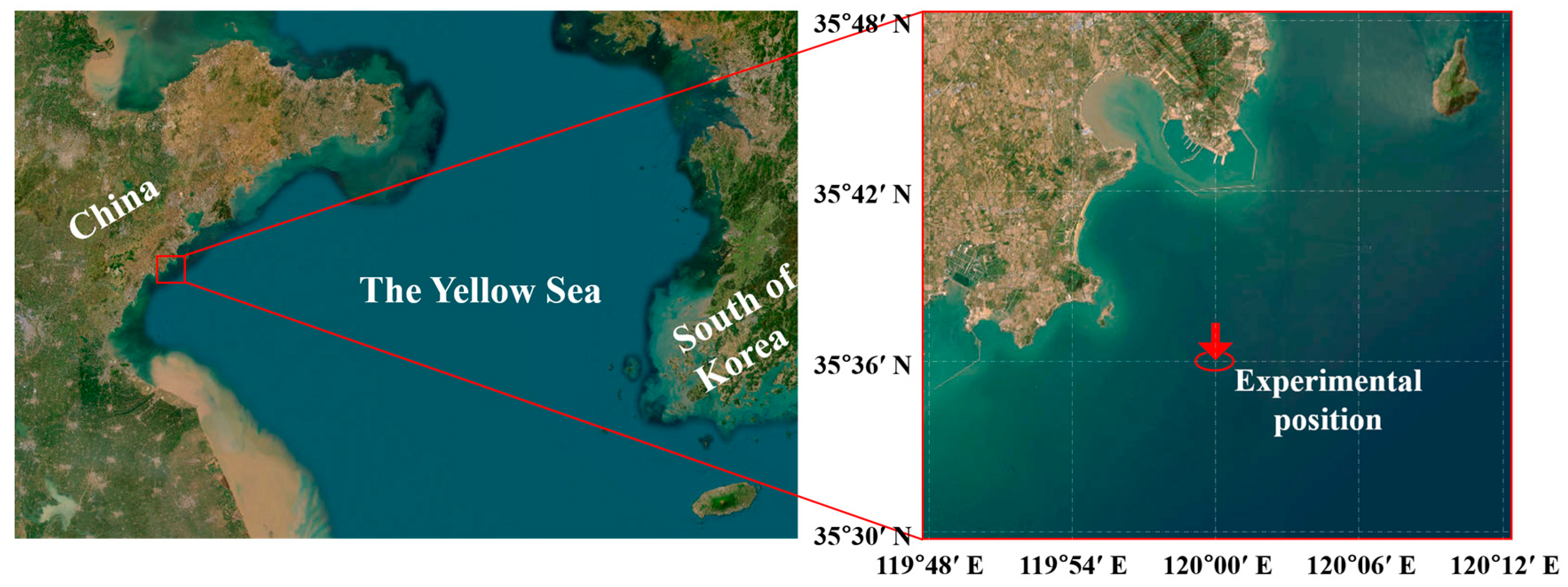

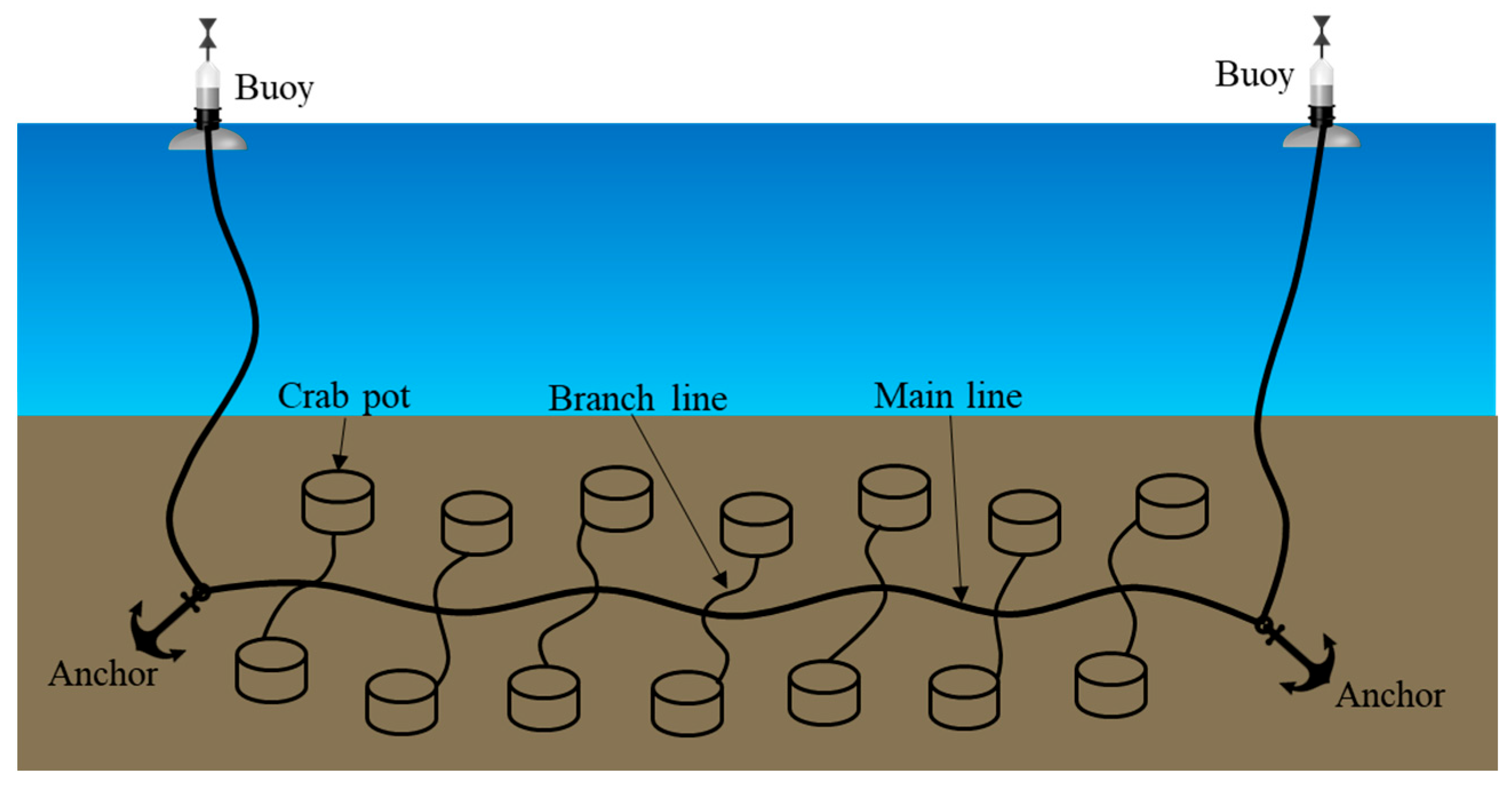
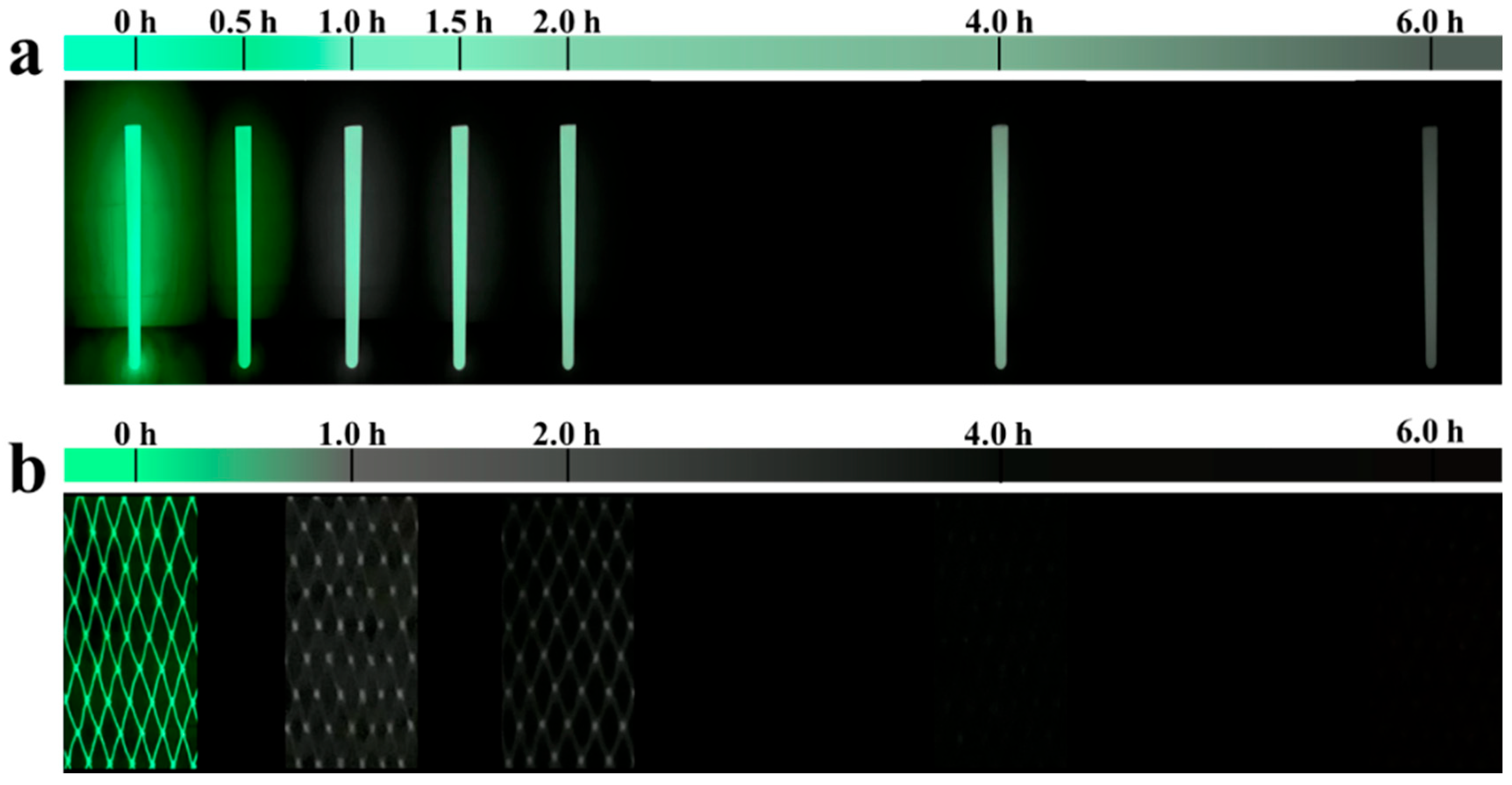
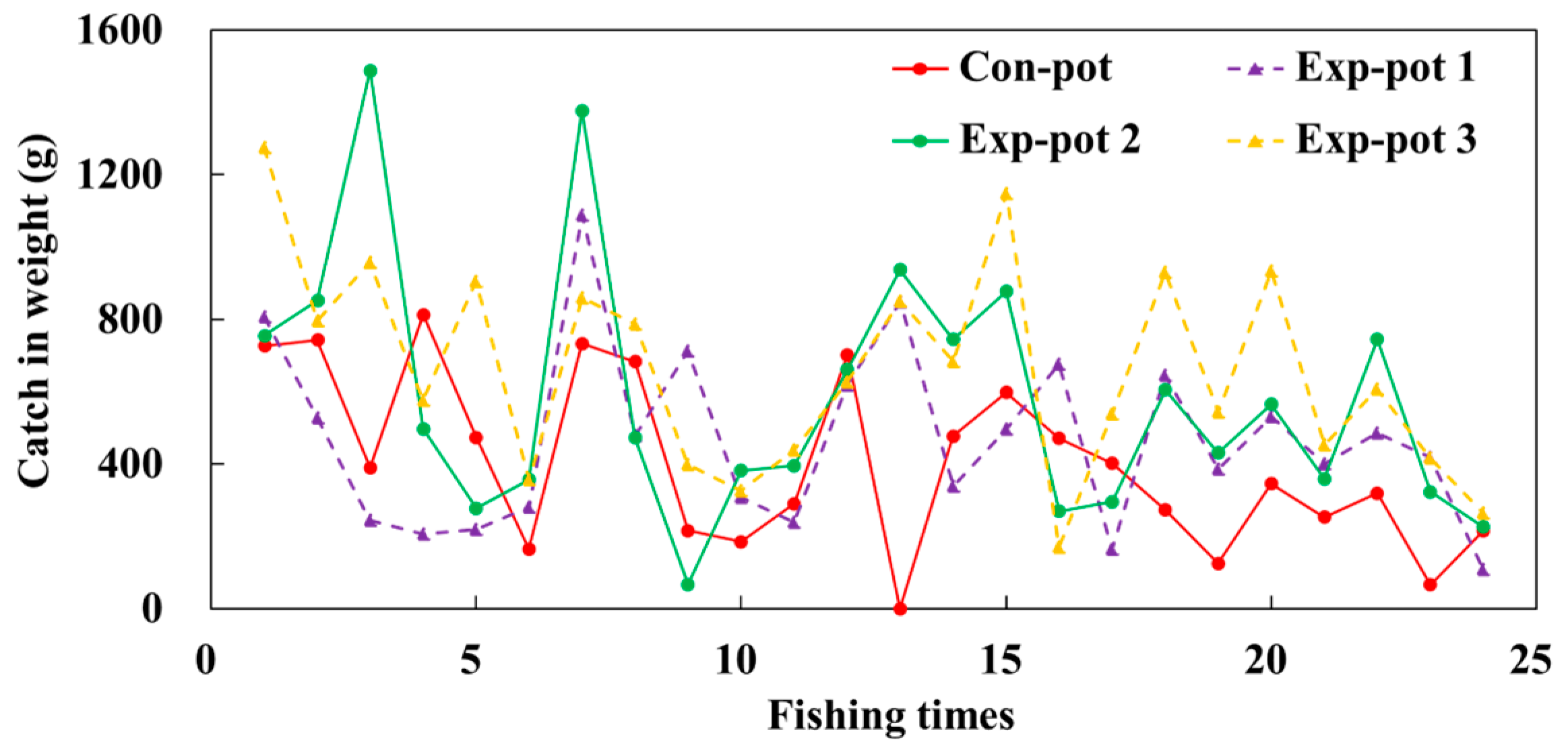
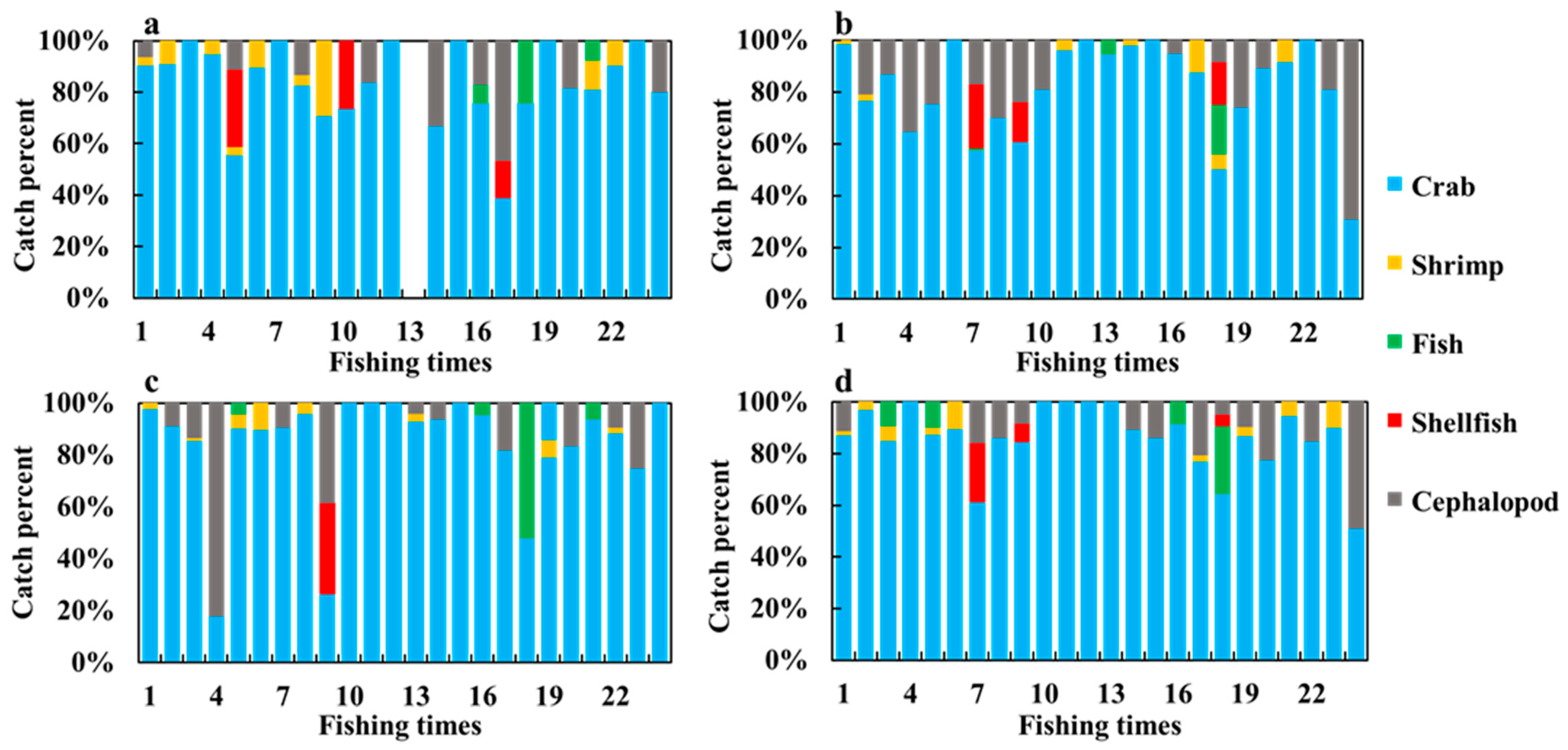

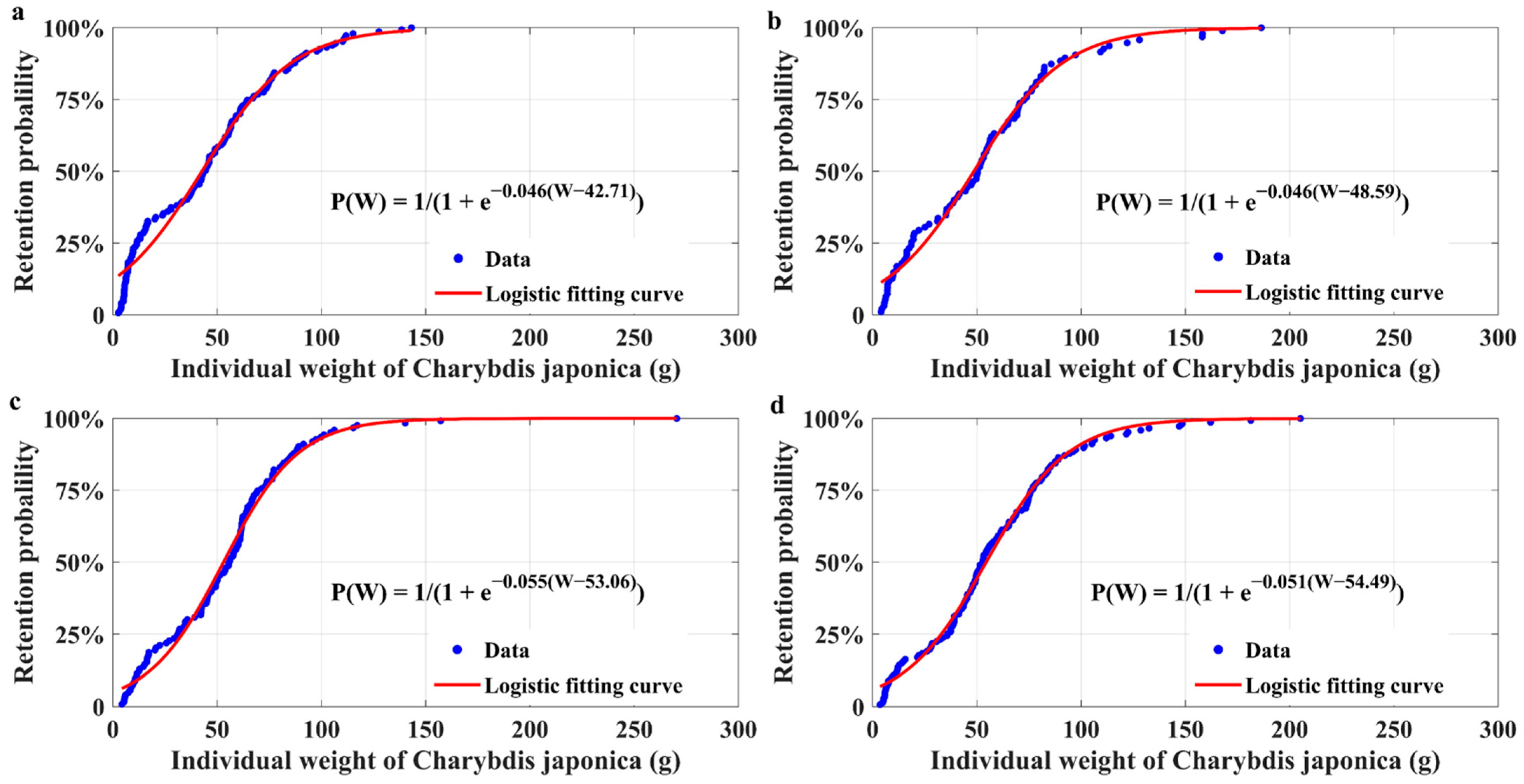
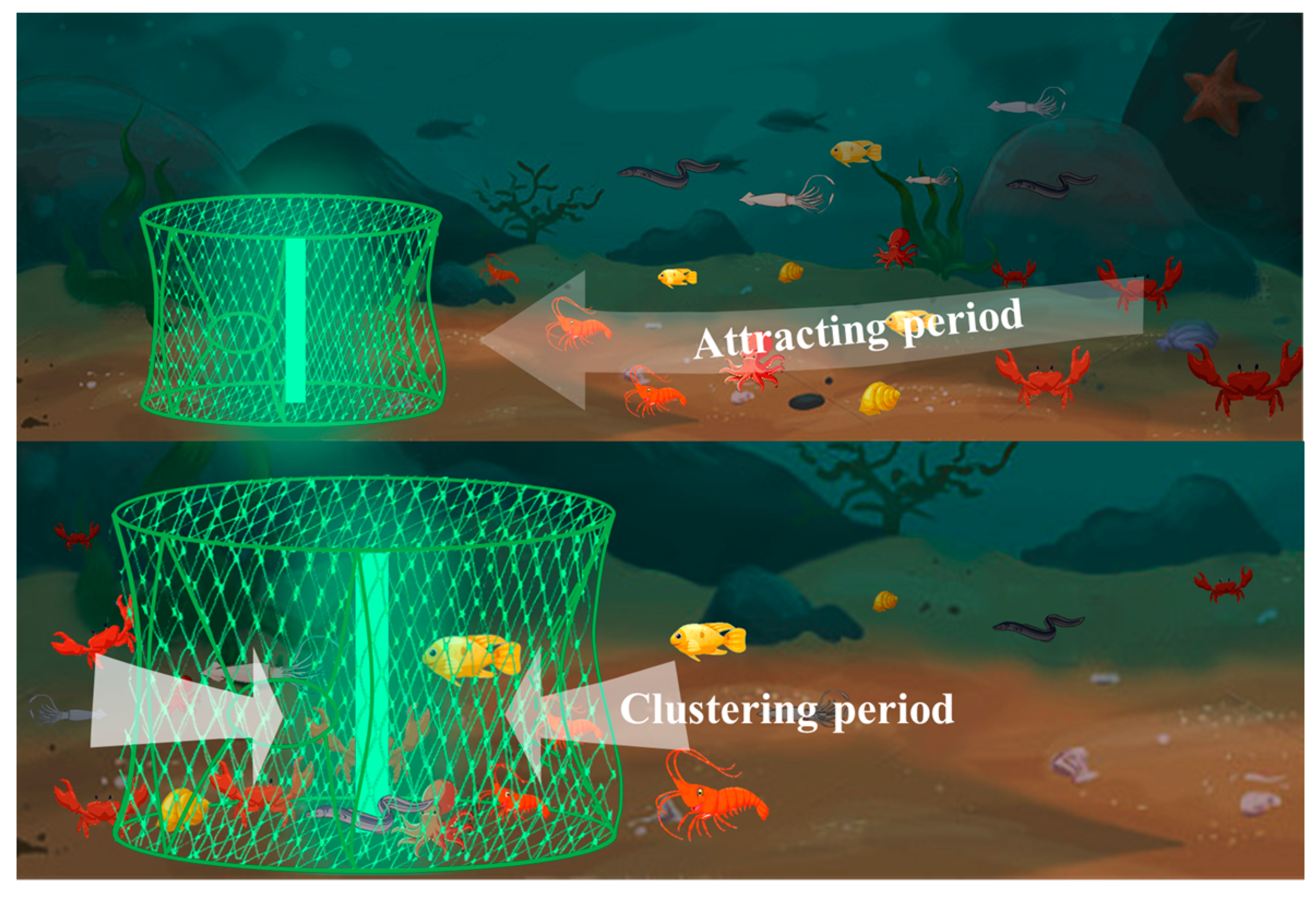
| Weight of Catch (g) | Number of Individuals | ||||||||
|---|---|---|---|---|---|---|---|---|---|
| Con-pot | Exp-pot 1 | Exp-pot 2 | Exp-pot 3 | Con-pot | Exp-pot 1 | Exp-pot 2 | Exp-pot 3 | ||
| Crab | Charybdis japonica | 6660.5 | 5576.2 | 6763.5 | 8479.4 | 147 | 99 | 123 | 143 |
| Portunus trituberculatus | 528.9 | 1544.5 | 1332.9 | 2198.3 | 11 | 29 | 17 | 25 | |
| Paguridae | 861.0 | 1817.9 | 3584.6 | 2814.0 | 8 | 11 | 11 | 12 | |
| Ranina ranina | 152.7 | 212.3 | 226.7 | 83.0 | 5 | 6 | 7 | 3 | |
| Portunus pelagicus | 0 | 0 | 109.7 | 0 | 0 | 0 | 6 | 0 | |
| Cephalopods | Octopus ocellatus | 724.2 | 1246.2 | 1298.7 | 1289.4 | 14 | 20 | 21 | 18 |
| Shrimp | Oratosquilla oratoria | 315.0 | 136.7 | 170.1 | 159.7 | 11 | 8 | 9 | 11 |
| Caridina cantonensis | 0 | 0 | 0 | 40.7 | 0 | 0 | 0 | 1 | |
| Shellfish | Busycon canaliculatu | 249.5 | 511.8 | 151.1 | 71.1 | 3 | 4 | 3 | 2 |
| Meretrix meretrix | 0 | 0 | 0 | 197.7 | 0 | 0 | 0 | 1 | |
| Fish | Hexagrammos otakii | 35.2 | 0 | 0 | 14.5 | 1 | 0 | 0 | 1 |
| Zoarces elongatus | 66.8 | 35.8 | 24.4 | 96.8 | 2 | 1 | 1 | 3 | |
| Paralichthys olivaceus | 19.2 | 0 | 0 | 0 | 1 | 0 | 0 | 0 | |
| Sebastodes fuscescens | 0 | 8.7 | 272.6 | 325.5 | 0 | 1 | 2 | 7 | |
| Crab Pot | 0–20 g | 20–40 g | 40–60 g | 60–80 g | 80–100 g | 100–120 g | 120–140 g | >140 g |
|---|---|---|---|---|---|---|---|---|
| Con-pot | 32.65% | 12.24% | 24.49% | 14.97% | 8.16% | 5.44% | 1.36% | 0.68% |
| Exp-pot 1 | 27.37% | 12.63% | 23.16% | 17.89% | 9.47% | 3.16% | 2.11% | 4.21% |
| Exp-pot 2 | 18.70% | 12.20% | 24.39% | 26.83% | 11.38% | 4.07% | 0.00% | 2.44% |
| Exp-pot 3 | 17.02% | 15.60% | 28.37% | 15.60% | 12.06% | 4.96% | 2.84% | 3.55% |
| Crab Pot | W50 (g) | SR (g) | b |
|---|---|---|---|
| Con-pot | 42.71 | 18.83–66.59 | 0.046 |
| Exp-pot 1 | 48.59 | 24.70–72.46 | 0.046 |
| Exp-pot 2 | 53.01 | 33.04–72.98 | 0.055 |
| Exp-pot 3 | 54.49 | 32.95–76.03 | 0.051 |
Disclaimer/Publisher’s Note: The statements, opinions and data contained in all publications are solely those of the individual author(s) and contributor(s) and not of MDPI and/or the editor(s). MDPI and/or the editor(s) disclaim responsibility for any injury to people or property resulting from any ideas, methods, instructions or products referred to in the content. |
© 2025 by the authors. Licensee MDPI, Basel, Switzerland. This article is an open access article distributed under the terms and conditions of the Creative Commons Attribution (CC BY) license (https://creativecommons.org/licenses/by/4.0/).
Share and Cite
Liu, W.; Min, M.; Wang, Z.; Liu, Y.; Wang, L.; Zhang, X. Noctilucent Crab Pots in the Yellow Sea, China: Field Evidence for Catch Efficiency Enhancement and Sustainable Crab Fishery Practices. Fishes 2025, 10, 481. https://doi.org/10.3390/fishes10100481
Liu W, Min M, Wang Z, Liu Y, Wang L, Zhang X. Noctilucent Crab Pots in the Yellow Sea, China: Field Evidence for Catch Efficiency Enhancement and Sustainable Crab Fishery Practices. Fishes. 2025; 10(10):481. https://doi.org/10.3390/fishes10100481
Chicago/Turabian StyleLiu, Wei, Minghua Min, Zhongqiu Wang, Yongli Liu, Lumin Wang, and Xun Zhang. 2025. "Noctilucent Crab Pots in the Yellow Sea, China: Field Evidence for Catch Efficiency Enhancement and Sustainable Crab Fishery Practices" Fishes 10, no. 10: 481. https://doi.org/10.3390/fishes10100481
APA StyleLiu, W., Min, M., Wang, Z., Liu, Y., Wang, L., & Zhang, X. (2025). Noctilucent Crab Pots in the Yellow Sea, China: Field Evidence for Catch Efficiency Enhancement and Sustainable Crab Fishery Practices. Fishes, 10(10), 481. https://doi.org/10.3390/fishes10100481







